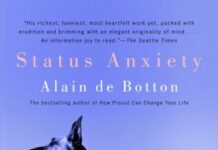
Ebook Info
- Published: 2008
- Number of pages: 223 pages
- Format: PDF
- File Size: 8.01 MB
- Authors: Alain de Botton
Description
A wise and utterly original book of travel essays from an international bestselling author that will “give one an expansive sense of wonder” (The Baltimore Sun). Any Baedeker will tell us where we ought to travel, but only Alain de Botton will tell us how and why. With the same intelligence and insouciant charm he brought to How Proust Can Save Your Life, de Botton considers the pleasures of anticipation; the allure of the exotic, and the value of noticing everything from a seascape in Barbados to the takeoffs at Heathrow. Even as de Botton takes the reader along on his own peregrinations, he also cites such distinguished fellow-travelers as Baudelaire, Wordsworth, Van Gogh, the biologist Alexander von Humboldt, and the 18th-century eccentric Xavier de Maistre, who catalogued the wonders of his bedroom. The Art of Travel is a “refreshing and profoundly readable” book (The Philadelphia Inquirer). Don’t leave home without it.
User’s Reviews
Reviews from Amazon users which were colected at the time this book was published on the website:
⭐Far too often, we seek out the exotic, but there is magic in our everyday surroundings… the clouds, the buildings, people …. Our daily lives in urban areas are full of beautiful and captivating sounds and sights, and Alain de Botton’s book is a thought provoking exploration of the mindset of the traveler, and how careful and deliberate observation is key to enjoying a rich and fulfilling life.
⭐This is not a “how to” or “why to” of travel. More like, grab a nice cup of tea, sit down with a good companion and talk about those esoteric/subtle facets of travel. You’ll walk away looking at travel with a new perspective, enriching your future travels and ideas of travel.”Cons:”A chapter or two felt a bit slow to me and, it would have been nice if the pictures were in color or were better optimized for gray scale printing. Fortunately, the ones that have this issue to my eyes are not critical to enjoyment of the book.
⭐Wow, what a thought provoking book! For someone who has a ferocious appetite to travel (and does both personally and for work) it gave me a fresh perspective on how one should go about traveling and experiencing the world. This is a story of de Botton’s experiences intertwined with stories from some of the greats of our history (e.g. Pascal, Neitzsche, Baudelaire etc.). It literally takes you on a journey from the anticipation of travel all the way through to the return to your home and life.I normally would read this book quite quickly however throughout there were sections that made me stop and reflect on my own travel experiences. At each page turn my values and approaches to travel was challenged and critiqued and I loved it!Three key takeaways from the book:1. I’m torn between Pascal’s perspective of truly enjoying and taking in a historical artifact (or art) versus being an artist where you take in what you see and then create something unique and creative that enhances the experience for you and for others. I believe that there is room for both depending on the situation. Such as life today where people photograph and video things versus stopping to just enjoy the experience.2. We want to be happy in our lives and travel seems to provide us with a mechanism to do that. The problem is that we only experience this happiness while traveling because we are outside of the constraints of work and our struggle to survive3. De Botton advocates travelling alone to be an advantage. He believes that responses to the world are molded by the company that we keep, therefore we align our curiosity to fit in with the expectations of others.
⭐Alan deBotton begins this book with the observation thattravel is often disappointing. What we see when we travelis often what we could see anywhere. Worse yet, we bringour neurotic selves along wherever we go. The observation isnot new (Montaigne’s essay On Solitude comes to mind as aforebearer), but it is certainly apt.Is there a curefor travelers’ boredom? More importantly, is travel ofany real value?In a series of chapters, the author suggests that there is.* Seize the chance that trains and planes offer to detachthe mind from the ordinary and to simply think.* Follow the example of Flaubert and recreate your identity.Are you secretly Polynesian? Parisian? Pelopennesian? Go for it.* Feed your curiosity before you go. Recognize that genuinecuriosities are seldom organized geographically.* Allow landscape to move you, thrill you and humble you.* Let the power of art influence how you see. Going to Provence?Study Van Gogh before you go.* Learn to sketch, however badly, as a way of turning yourmind to what’s in front of you* Shake off the habits of perception that dull you toexperience-try seening your everyday world as if forthe first time.Does this approach work? It has for me. Every goodtrip-that is, every one that’s had immediate and long-termpleasant effect has been grounded in at least one of thoseprinciples.Of course, you may suspect that deBottton is putting uson. There is a sense that he may be doing parody, takingon the self-help genre out of a wicked sense of fun. Thebook is padded out with ninety pages of blank sheets andsome equally blank illustrations. There are times when itseems that the author is rambling in his descriptions forthe sake of the word count and a few truly awful constructionsmade it past the editor-`mutinous North Sea waves’. Is `foregrounded’ a verb?No matter, whatever the author’s intentions, the resultis worthwhile: an alert that calls us to a realistic programfor reviving the joy of travel.–Lynn Hoffman, author of THE NEW SHORT COURSE IN WINE andthe forthcoming novel bang BANG from Kunati Books.
⭐This is the book that completely revolutionised our approach to travel, opening our eyes to our surroundings, putting us in touch with our environment …… this book is mindfulness personified.Structurally the book is divided into four main sections ……… Departure, Motives, Landscape, Art, with each one being the focus of ones mindfulness in a particular place. So, in the Art section we visit Provence for a while and enjoy it through the eyes of Van Gogh. This is the really clever thing about de Botton’s writing here, each section also has a guide with Van Gogh visiting Provence as mentioned and seeing the environment quite differently from his contemporaries, especially in terms of bright primary colours and swirls rather than pastels and straight lines. In the second half of the Art section our guide is John Ruskin who coined the expression “Word-Painting” and de Botton demonstrates Ruskin’s ability to write about buildings, nature, and of course his surroundings in The Lake District.In Departure our guides are Huysmens, Baudelaire and Hopper; in Motives it’s Flaubert and von Humboldt; and in Landscape it’s Wordsworth, Burke and Job.I loved every section of this book, though the subsection, Curiosity which is inside the main section Motives was my favourite; set in modern day Madrid with Alexander von Humboldt, a young 18th century explorer as my “guide” this young man set off on a 5 year expedition to South America 10 years BEFORE Charles Darwin was even born! The chapter alternates between de Botton experiencing the architecture of Madrid during his first ever visit and Von Humboldt’s observation and classifying of sea temperatures, plant life, animals, insects, mapping, water sources. It is here that the author distinguishes between different types of curiosity when travelling, and which are typified in this extract:”For Humboldt, the question had been, ‘Why are there regional variations in nature?’ For the person standing before the Iglesia de San Francisco El Grande, a question might be, ‘Why have people felt the need to build churches?’ or even, ‘Why do we worship God?’ From such a naïve starting point, a chain of curiosity would have the chance to grow, involving questions like, ‘Why are churches different in different places?’, ‘What have been the main styles of churches?’ and ‘Who were the main architects and why did they achieve success?’ Only through such a slow evolution of curiosity could a traveller stand a chance of greeting the news that the church’s vast neo-classical façade was by Sabatini with anything other than boredom or despair. A danger of travel is that we see things at the wrong time, before we have had a chance to build up the necessary receptivity and when new information is therefore as useless and fugitive as necklace beads without a connecting chain.”This last sentence from de Botton highlights what has often happened to me in many a city when walking around unmindfully or without prior research to channel my curiosity. For example, try standing at The Cross in Chester’s Roman, Medieval … city. Face down towards Eastgate street and admire the Roman Eastgate adorned with a Victorian Jubilee clock in the distance, back up a bit and take in the Tudor black and white architecture sheltering the Medieval Rows, and come into the foreground to the Saxon Cross. And that’s before you’ve chosen to turn right down Bridge Street with a few Georgian buildings on your right, or gone left up Northgate Street to view the sandstone Gothic Revival town hall! I’m not sure if I’m getting this across well, but clearly walking around a city like this dodging between the Roman, the Tudor, the Georgian and the Victorian is NOT Mindful Curiosity! Instead, still in Chester, visit the museum first and explore the Roman exhibits, then walk out to explore the Amphitheatre, followed by The Roman Gardens along the Roman Wall. Ask yourself this question … Was Chester intended as the capital of Britain before the Roman era dissipated? Now THAT is travel curiosity that goes beyond the factual!And so finally, a confession, the book has a 5th section called “Return” which focuses on returning home after travel, and as usual we have a guide … Xavier de Maistre. Xavier wrote a book called Voyage autour de ma chambre (1794), (Journey around my room), a parody set in the tradition of the grand travel narrative, which is an autobiographical account of how a young official, imprisoned in his room for six weeks, looks at the furniture, engravings, etc., as if they were scenes from a voyage in a strange land. He praises this voyage because it does not cost anything, and for this reason it is strongly recommended to the poor, the infirm, and the lazy.Now, I am neither poor, nor infirmed, nor lazy, but this section of de Botton’s book was the ultimate eye opener. For those regular readers of our blog, this was THE influence that got us exploring our local environment, especially English churches within a 10 miles radius, that hide so much English history. We have discovered English Civil War tales, abandoned villages because of The Black Death, Wall Paintings and their significance to illiterate peasants during the Dark Ages, links to Oxford University Colleges, Saxon fonts, the most complete set of stained glass windows in England, a second Robin Hood ….. quite a good book really!
⭐This is a delightful and insightful book that has obviously been written with great care. Some of the phrasing and imagery it creates is exquisite, and the ideas it conveys are quite profound.By way of introduction, Alain de Botton points towards the vast array of books with advice on where to travel to, whilst we seldom ask why we go and how we might become more fulfilled by doing so. In asking these questions he invites us to explore much more than the nature of travel, but what the Greek philosophers beautifully termed eudemonia, or human flourishing.The book, complete with many appropriate illustrations, explores the nature of travel through the eyes of critics, writers, thinkers and travellers of all sorts, all neatly correlated to the authors personal experience. The result is a delightfully well written invitation to explore our own thinking. This process is laced with opportunities for new insights. For example the discovery that when we travel we may leave everything behind, but can’t avoid being accompanied by ourselves, perhaps the very thing we most seek a break from.I think my favourite chapter is one in which Alain explores the Provence region of France through the eyes of Vincent Van Gogh. He described how on first encountering the region he found no real charm or magic in the scenery. However having explored how Van Gogh saw and captured the region through his paintings he reveals how he was taught to see in new ways. This experience itself reveals a number of powerful insights about how we see and are able to see the world, but beyond this it revealed to me for the first time the true nature of an artist’s role in creating new ways in which to see.I highly recommend this book. The use of language is beautiful and the insights are delicately observed and delivered with humour and obvious affection.”A few years after Van Gogh’s stay in Provence, Oscar Wilde remarked that there had been no fog in London before Whistler painted it. There had surely been fewer cypresses in Provence before Van Gogh painted them.”
⭐I am a big fan of some of Alain’s other books and Ted talks so this book has been on my radar for some time. You get the usual philosophy, literature and art but ultimately it was a bit of a let down. Travel is a highly personal experience and I get the impression that he doesn’t care much for the experience and sees the persuit as over rated and boring. I feel that the title is over reaching and that Alain isn’t qualified to write about this subject.
⭐This is a brilliant book. I would recommend it to anyone. It really touches on thoughts and feelings that I have during travel, that I had never managed to put into concrete words. My only objection is the title, this really is not a how to book, and for the better.
⭐Unlike De Botton, I’m seldom disappointed with my travels, but I share his curiosity about considering why we want to travel in the first place.De Botton achieves this by reflections on the thoughts and experiences of other travellers, whether explorers, writers or other artists. What makes The Art of Travel particularly enjoyable is the realisation that many before have gone through the trials and rewards of travelling.Perhaps not surprisingly, De Botton identifies more with the trials. But he is a fine writer, and even the perpetually happy traveller should read this book.
Keywords
Free Download The Art of Travel (Vintage International) in PDF format
The Art of Travel (Vintage International) PDF Free Download
Download The Art of Travel (Vintage International) 2008 PDF Free
The Art of Travel (Vintage International) 2008 PDF Free Download
Download The Art of Travel (Vintage International) PDF
Free Download Ebook The Art of Travel (Vintage International)




